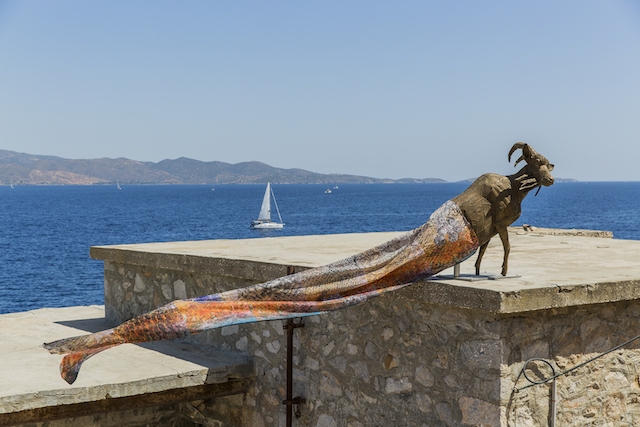High up the steep track from Hydra’s port, standing on the roof of the old slaughterhouse looking back to mainland Greece, is a goat cast in copper. This animal, unlike its fur-and-blood brethren who can be occasionally spotted sauntering around the Saronic island, sports a scaly, fishlike tail. The slaughterhouse serves as the diminutive project space of the Deste Foundation, and the goat is a sculpture by Kiki Smith. The goat is joined by a merman, depicted two-dimensionally in cut and engraved copper, who shelters from the sun inside the grey stone building; a mermaid; a few cats; and an owl, all likewise perched in the shadows. They meditate upon a couple of icons: a font, also in copper, containing a pool of water; a lamp hosting a beeswax candle. Each of the merpeople are engraved with constellations. Stained-glass windows add to the contemplative atmosphere, and a series of blue-and-white flags, heralding the dusty path up to this remote (at least for an art institution) location, also boast diagrammatic designs alluding to astrology.
A goat with a tail is the sign of Capricorn. The work is not a departure for Smith. Since the mid-1990s, in a career that has spanned sculpture, etching, painting and weaving, the American artist has mined ideas regarding the symbolism and mythology of animals, touching on alternative belief systems. Astrology, and astronomy, have been recurring interests (mermaids and cats are also a mainstay), science and quasi-spiritualism coexisting. This show proves no exception, yet the location imbues a heightened intensity – I saw it as the sun was setting over the sea. After dusk the real stars came out. It was all very romantic.
Before the seventeenth century, or the Age of Reason, there was little distinction between the measuring and mapping of the universe – astronomy – and the use of those observations to calculate the apparent effect of the stars on events on earth, ie astrology. (Many of the early advances in astronomy were financed through the latter, mostly through the patronage of the royal courts.) Man was made of the universe, created by God from dust on the sixth day, so it was logical that the movement of the cosmos and the actions of man were inextricably linked – that one could be understood through the other. Smith seems to agree. Which is where the rub of this viscerally affecting show lies. Astrological beliefs – to which Smith has confirmed she is sympathetic in interviews – minimise human agency. That’s an age-old observation: Edmund in King Lear (c. 1606) says astrology ‘is the excellent foppery of the world, that when we are sick in fortune, often the surfeits of our own behaviour, we make guilty of our disasters the sun, the moon and stars’. Yet when questions of humanity’s effect on climate change are being put up for spurious debate, and an antiscience, antiexpert rhetoric is being ramped up by populist blowhards, these seemingly harmless beliefs take a more sinister hue. Rather than the universe controlling our lives through the movement of the stars, it is we who are in charge of (terrestrial at least) nature. And we’re not doing a very good job of it. True, if a 97 percent consensus on manmade climate change within the scientific community fails to spur industrial-scale action, an artwork won’t either: yet if art is to be more than foppery, artists have a responsibility to play their part in resisting a new age of unreason.
Kiki Smith: Memory at Deste Foundation Project Space, Slaughterhouse, Hydra, 18 June – 30 September
